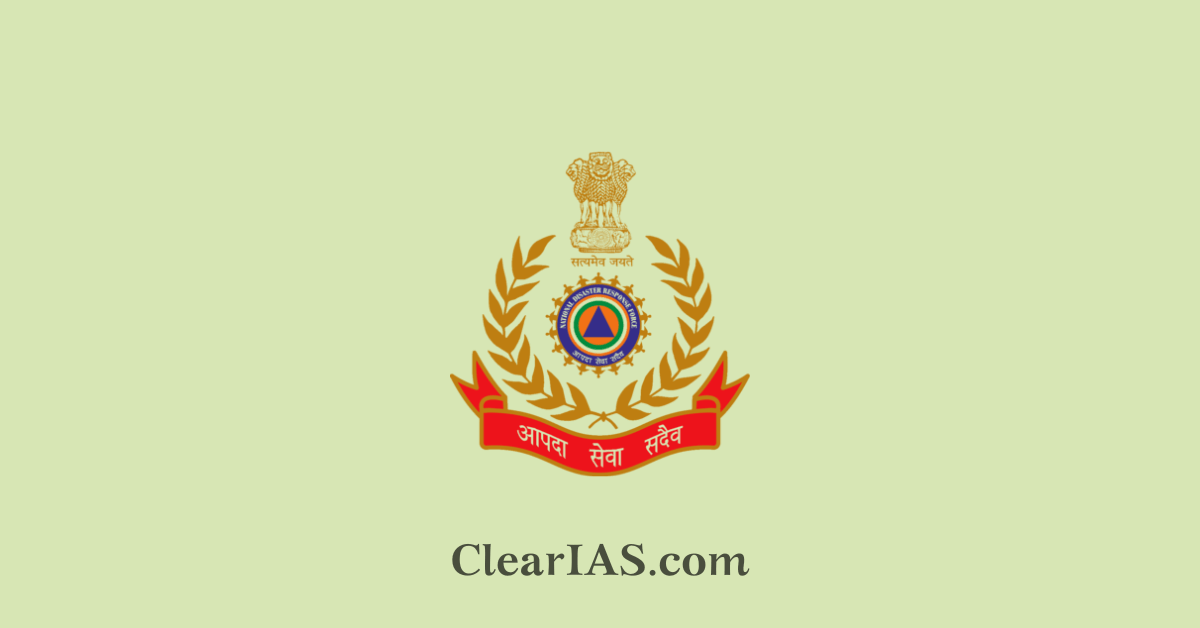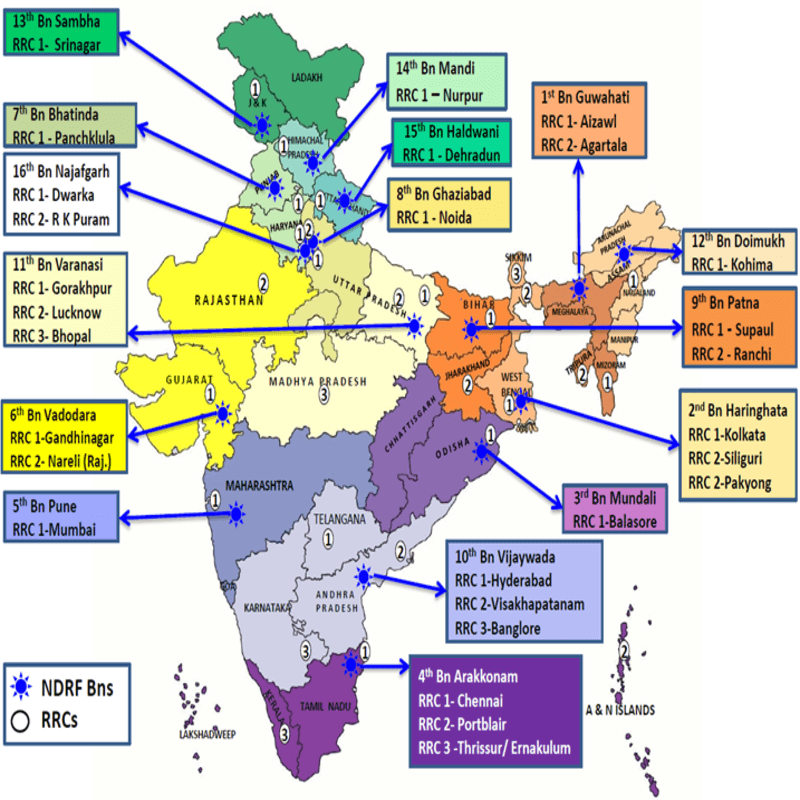
The Disaster Management Act of 2005 established the National Disaster Response Force (NDRF), an Indian specialized force, “for a special response to a threatening disaster scenario or disaster.” Read here to learn more about the NDRF.
In India, the State Government is in charge of disaster management. The Ministry of Home Affairs is the central government’s “Nodal Ministry” for managing natural disasters (MHA).
The Central Government is in charge of providing aid and assistance to the affected state in the event of “calamities of severe nature,” including the deployment, at the State’s request, of Armed Forces, Central Paramilitary Forces, the National Disaster Response Force (NDRF), and any other communication, air, and other assets that are available and required.
The National Disaster Response Force (NDRF) Raising Day is commemorated on January 19, every year. Since the Force’s formation in 2006, the personnel has played a crucial role in the country’s disaster management and community awareness for Disaster Risk Reduction (DRR).
Also read: Crowd Management
National Disaster Response Force (NDRF)
The mid-nineties and the subsequent decade saw much international debate & discussion around Disaster Response & Preparedness.
- Some of the notable and more impactful ones were the Yokohama Strategy Plan (1994) & the Hyogo Framework for Action (2005), adopted by the UN.
During the same period, India faced some of its most severe natural calamities like the Orissa Super Cyclone (1999), the Gujarat Earthquake (2001), and the Indian Ocean Tsunami (2004).
This succession of events and the international environment brought to the fore, the need for a comprehensive disaster management plan. This led to the enactment of the Disaster Management Act on December 26th, 2005. The National Disaster Management Authority (NDMA) was constituted to lay down the policies, plans, and guidelines for disaster management.
The Disaster Management Act has statutory provisions for the constitution of the National Disaster Response Force (NDRF) for the purpose of specialized response to natural and man-made disasters.
- Accordingly, in 2006 NDRF was constituted of 8 Battalions.
- At present, NDRF has a strength of 15 Battalions with each Battalion consisting of 1149 personnel.
In the beginning, the personnel of NDRF was deployed for routine law and order duties also. In a meeting of the NDMA with the Prime Minister on October 25, 2007, the need for NDRF to be made a dedicated force was highlighted and accepted.
Organization

The Apex Body for Disaster Management in India is the National Disaster Management Authority (NDMA). The Chairman of the NDMA is the Prime Minister.
The head of the NDRF is designated as Director General. The Director Generals of NDRF are IPS officers on deputation from Indian police organizations. Director General is a three-star officer.
- At present, National Disaster Response Force consists of 15 battalions from the BSF, CISF, CRPF, ITBP, SSB, and Assam Rifles.
- Each battalion has 18 self-contained specialist search and rescue teams of 45 personnel including engineers, technicians, electricians, dog squads, and medical/paramedics.
- The total strength of each battalion is 1149.
- All 15 battalions have been equipped and trained to respond to natural as well as man-made disasters.
- Battalions are also trained and equipped for a response during chemical, biological, radiological, and nuclear (CBRN) emergencies.
These NDRF battalions are located at 16 different locations in the country based on the vulnerability profile of the country and to cut down the response time for their deployment at the disaster sites.
Functions of the National Disaster Response Force
The National Disaster Response Force’s mission is to create a safer and more disaster-resilient India through the creation of a comprehensive, pro-active, multi-disaster, and technology-driven disaster management plan.
This must be accomplished through the development of a culture of disaster preparedness, mitigation, and pre-order to provide a quick and effective response.
This national vision seeks, among other things, to instill a readiness culture among all stakeholders.
By conducting highly skilled rescue and relief operations, regular and intensive training and re-training, familiarisation exercises within the respective NDRF Battalions’ areas of responsibility, and conducting mock drills and joint exercises with the various stakeholders, the NDRF has demonstrated its significance in achieving this vision.
Besides the professionalism shown during rescue operations in floods and cyclones and collapsed structure search and rescue (CSSR) operations, NDRF has also acquired considerable expertise in facing CBRN (Chemical, Biological, Radiological & Nuclear) challenges.
NDRF has also aided in international operations like the Japan tsunami of 2011 and the Nepal earthquake of 2015.
National Disaster Response Fund
The National Disaster Response Fund, constituted under Section 46 of the Disaster Management Act, 2005, supplements the State Disaster Response Fund (SDRF) of a State, in case of a disaster of severe nature, provided adequate funds are not available in SDRF.
- It is placed in the “Public Account” of the Government of India under reserve funds not bearing interest.
- Expenditures from it are not required to be approved by the Parliament.
State Disaster Response Fund
The State Disaster Response Fund (SDRF), constituted under Section 48 (1) (a) of the Disaster Management Act, 2005, is the primary fund available to State Governments for responses to notified disasters.
- The Central Government contributes 75% of SDRF allocation for general category States/UTs and 90% for special category States/UTs (NE States, Sikkim, Uttarakhand, Himachal Pradesh, Jammu, and Kashmir).
- The annual Central contribution is released in two equal installments as per the recommendation of the Finance Commission.
- SDRF shall be used only for meeting the expenditure for providing immediate relief to the victims.
Disasters covered under SDRF: Cyclones, drought, earthquakes, fires, floods, tsunamis, hailstorms, landslides, avalanches, cloudbursts, pest attacks, frost, and cold waves.
Local Disaster: A State Government may use up to 10 percent of the funds available under the SDRF for providing immediate relief to the victims of natural disasters that they consider to be ‘disasters’ within the local context in the State and which are not included in the notified list of disasters of the Ministry of Home Affairs.
Government initiatives for disaster management
National Cyclone Risk Mitigation Project (NCRMP)
- Recurrent cyclones account for large-scale deaths, loss of livelihood opportunities, loss of public and private property, and severe damage to infrastructure.
- To reduce the loss of life and properties in the event of future calamities, the National Cyclone Risk Mitigation Project (NCRMP) has been launched by the Ministry of Home Affairs, with support from the World Bank, in two phases, in the cyclone-prone coastal states and Union Territories.
- The National Disaster Management Authority (NDMA) has been designated as the implementation agency.
National Disaster Response Reserve (NDRR)
- The 13th Finance commission recommended for creation of a National Disaster Response reserve (NDRR) with a corpus of Rs.250 crore as a Revolving Fund to meet the immediate requirement of relief material/equipment after a disaster.
- The purpose of creating the National Disaster Response Reserve (NDRR) is to mitigate the sufferings of the victims of the disaster which are beyond the coping capacity of the States.
Aapda Mitra Scheme
- The NDMA has approved a Centrally Sponsored Scheme focusing on training community volunteers in disaster response in the 30 most flood-prone districts of 25 states in India.
- Aim: To train community volunteers with the skills that they would need to respond to their community’s immediate needs in the aftermath of a disaster, thereby, enabling them to undertake basic relief and rescue tasks for emergencies such as floods, flash floods, and urban flooding, when emergency services are not readily available.
National Disaster Management Services
- The scheme has an integrated approach to provide reliable telecommunication infrastructure to disaster managers during times of non-disasters and in the event of disasters.
- It is an NDMA pilot project being implemented to provide the failsafe communication infrastructure and technical support for Emergency Operation Centers (EOCs) at MHA, NDMA, NDRF, 36 States/Union Territories, and 81 most vulnerable districts.
Mobile Radiation Detection System (MRDS)
- NDMA, as part of a pilot project on national-level preparedness to cope with Radiological Emergencies, has taken an initiative to equip police and NDRF personnel for the management of radiological emergencies in the public domain.
Conclusion
The practice of “proactive availability” of the National Disaster Response Force to the States and that of “pre-positioning”, in a threatening disaster situation have immensely helped minimize damage, caused due to natural calamities in the country.
The first major test of disaster for NDRF was Kosi Floods in 2008, which was handled by the force on a war footing.
NDRF has since its inception has shown great efficiency during and after major calamities. NDRF teams also assist the local administration by providing immediate relief and medical care to thousands of needy people.
The government of India also tries to strengthen disaster management and preparedness through international cooperation. India has numerous MoUs in the field of Disaster management with countries like Tajikistan, Mongolia, Bangladesh, Italy, Japan, SCO countries, Germany, SAARC countries, Russia, and, Switzerland.
-Article written by Swathi Satish






Leave a Reply